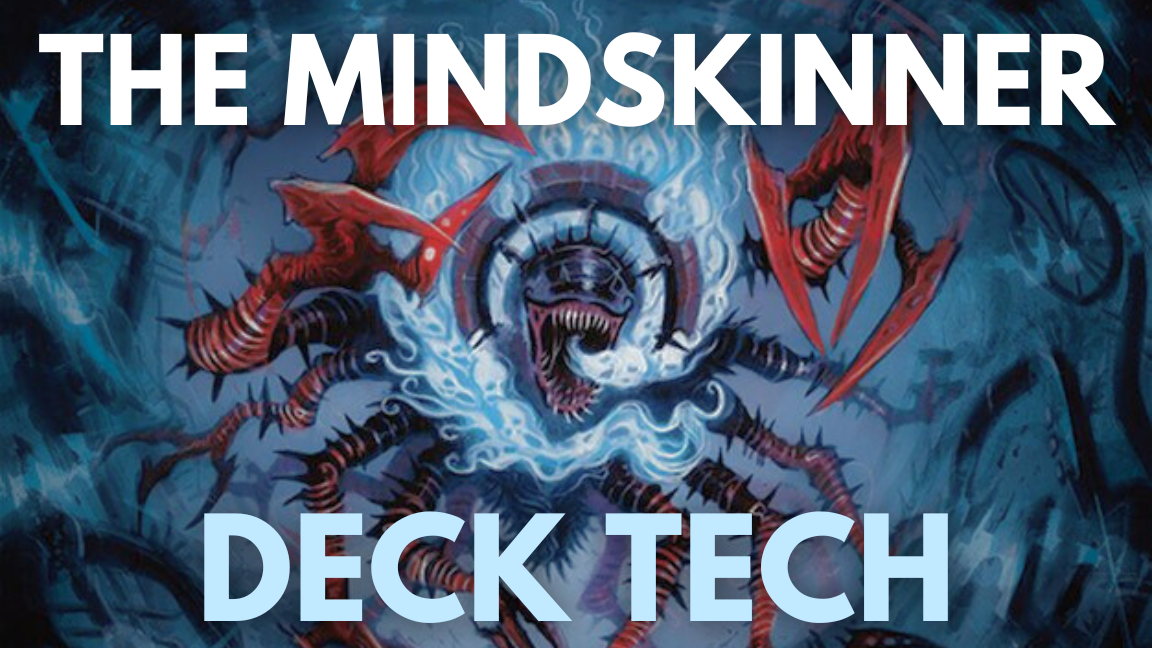The Mindskinner Deck Tech

The Mindskinner by Abz J Harding
What's too Painful to Remember We Simply Choose to Forget
Welcome to Duskmourn, Magic's House of Horrors and an ode to all that goes bump in the night. The house feasts on fears, so I thought it fitting to start with one of my greatest fears...memory loss. I keep a small yellow notepad with me because I've had issues with short-term memory loss since high school.
My grandfather on my dad's side suffered from dementia late in life, and I could only watch helplessly as his memories, relationships, and personality slipped away. It was terrifying to see the strong, kind, intelligent person I loved wither away into a shell of his former self. Mill in Magic is represented in the form of memory loss, including the staple Altar of Dementia
Core Synergy
The Mindskinner is a big, powerful beatstick, but one that comes with a major twist. 10 power of unblockability would seem to be an excellent source of repeatable damage, but its second ability prevents it and all sources I control from dealing damage. Why would we be willing to do this? Well, instead of dealing damage, we mill each opponent for that many cards. It's a bit like Kediss, Emberclaw Familiar
So, how do we capitalize on the ability to spread the damage? Well, by providing different sources, as well as by making our sources bigger. Essentially, we play like a stompy deck, except one that uses the Hydra Omnivore
Vantress Gargoyle
Win Conditions
Since we care about dealing large chunks of damage, equipment cards are a great way to amplify things. In particular, Sword of the Animist
Given that our commander mills (a controversial strategy), has a ton of power (which is threatening), and is a bit awkward at pivoting to a different game plan without its commander, we need ways to protect it. We are packing sources of Shroud, Hexproof, and Ward, as well as sources of Haste, so we can make The Mindskinner
One of the cuter interactions in the deck, if a deck built around literal nightmare fuel can HAVE cute interactions, is giving The Mindskinner
First, Mjolnir is a damage source we control, so Mindskinner triggers. Second, it hits each opponent and Mindskinner mills each opponent, so each opponent mills the total damage, not just what would have been dealt to them!
Masterwork of Ingenuity
Removal
Voltron decks, even those that don't fully commit to the bit, need to be ready to protect their threats. Mill decks need to be able to deal with the hate coming their way. As a result, we run a bit more removal than the average deck. After all, we want to make opposing us an absolute nightmare.
Stubborn Denial
Resculpt
March of Swirling Mist
When a permanent phases out, any Auras, Equipment, or Fortifications attached to that permanent phase out at the same time. This alternate way of phasing out is known as phasing out "indirectly."
Card Draw
If we're going to try to oscillate between offense and defense, we need to have the card advantage to support both plans. The more removal spells we use up, the fewer resources we have for other opponents' threats. The more aggressive we get, the harder it is to come back after an impactful board wipe or bit of removal.
Into the Story
The general plan is to present high-power threats and use them to quickly mill opponents and keep them off balance. If that fails, we have removal to torment opposing game plans and equipment to push through relevant amounts of damage. If games go long, we have the ability to draw chunks of cards in order to gain the resources needed to oscillate between presenting and removing threats.
The Mindskinner Deck Tech
View on ArchidektCommander (1)
Creatures (10)
Artifacts (20)
- 1 Bitterthorn, Nissa's Animus
- 1 Blackblade Reforged
- 1 Bonehoard
- 1 Brass Knuckles
- 1 Champion's Helm
- 1 Colossus Hammer
- 1 Commander's Plate
- 1 Excalibur, Sword of Eden
- 1 Fireshrieker
- 1 Inquisitor's Flail
- 1 Lavaspur Boots
- 1 Lightning Greaves
- 1 Masterwork of Ingenuity
- 1 Mjölnir, Storm Hammer
- 1 Nettlecyst
- 1 Strata Scythe
- 1 Swiftfoot Boots
- 1 Sword of the Animist
- 1 Thran Power Suit
- 1 Trepanation Blade
Instants (27)
- 1 Aetherize
- 1 An Offer You Can't Refuse
- 1 Brainstorm
- 1 Desynchronization
- 1 Didn't Say Please
- 1 Disallow
- 1 Drown in Dreams
- 1 Fierce Guardianship
- 1 Flow of Knowledge
- 1 Frantic Search
- 1 Into the Story
- 1 Keep Safe
- 1 Long River's Pull
- 1 March of Swirling Mist
- 1 Negate
- 1 Pongify
- 1 Rapid Hybridization
- 1 Reality Shift
- 1 Resculpt
- 1 Slip Out the Back
- 1 Spell Rupture
- 1 Strix Serenade
- 1 Stubborn Denial
- 1 Swan Song
- 1 Thought Collapse
- 1 Three Steps Ahead
- 1 Visions of Beyond
Sorceries (2)
Lands (40)
- 40 Island